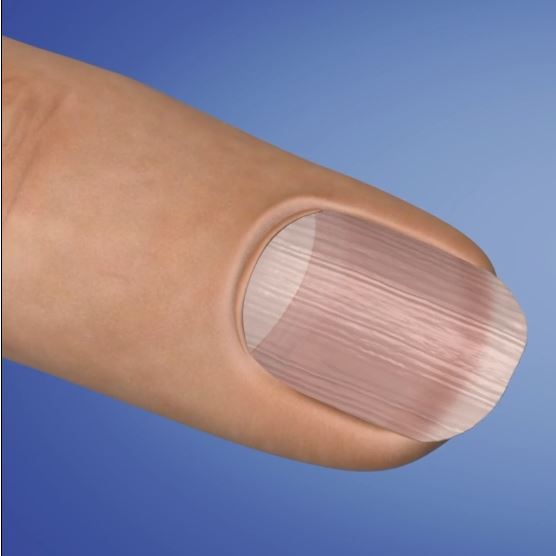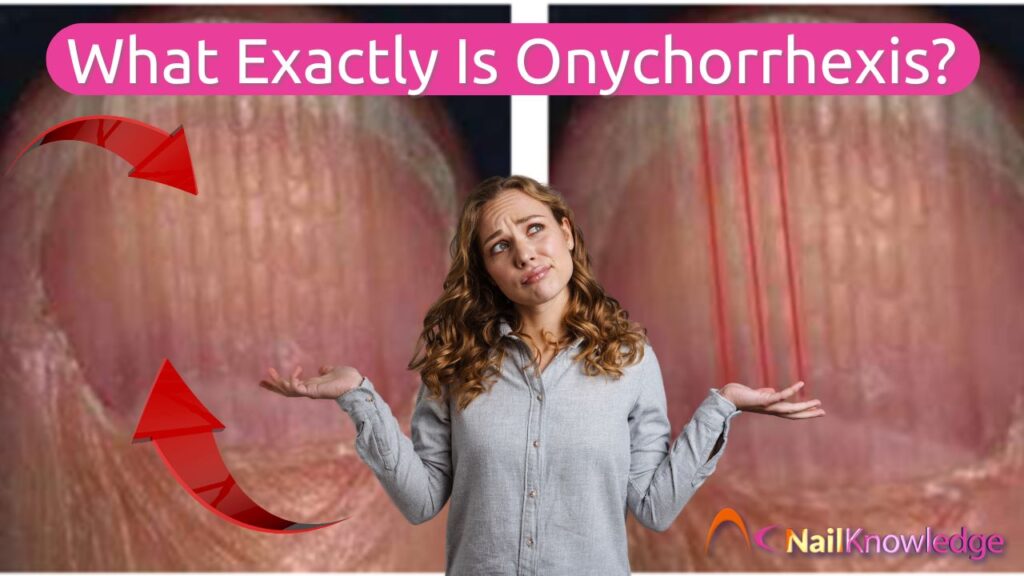Have you ever noticed vertical groves running up your nails? It’s not just a cosmetic concern; it could be a sign of onychorrhexis. Let’s unpack what this condition really means for your nail health.
What Exactly Is Onychorrhexis? It’s a fancy word for nail groves

Onychorrhexis – visible ridges in the nail plate
Onychorrhexis, from the Greek words “ónycho-” meaning nail and “rhexis” meaning bursting, is a condition characterized by longitudinal ridging or brittleness of the nails. It often appears as grooved lines that run from the cuticle to the tip of the nail. Sounds technical, right? Simply put, it’s when your nails get these vertical lines that can feel a bit rough when you run your finger over them.
Common Causes: Why Do My Nails Look Like This?
The causes of onychorrhexis can vary widely—from the way you treat your nails to your overall health. It’s often seen in:
- Aging: Just like the rest of our body, nails change as we grow older.
- Medical Conditions: Various diseases like hypothyroidism, eczema, and even rheumatoid arthritis can manifest symptoms in your nails.
- Nutritional Deficiencies: Lacking iron, protein, or folic acid? Your nails might show it.
When Should You Worry About Nail Groves (Onychorrhexis)?
Most of the time, those lines on your nails are more of an annoyance than a serious problem. But hey, what if your nails start to split or they become unusually brittle? That’s when you might want to pay a bit more attention.
Ridges in a nail plate with some ‘beading’ but the nail plate is intact.
These nails can be covered with a semi-permanent artificial nail product if you keep an eye out for any potential infections.
Open Beaded ridge nail plates
Beaded ridges can break open and cause the nail plate to unravel – these nail plates need to be improved before applying any or all artificial nail products.
Simple Home Remedies: Can I Fix This at My Kitchen Sink?
Absolutely! You don’t always need a doctor’s appointment to take care of your nails. Here are a few DIY tips:
- Moisturize: Apply natural oils like vitamin E or olive oil to your nails and the surrounding skin, finish with lotion or crème depending on your personal preference.
- Protect Your Nails: Wearing gloves while cleaning dishes or using harsh chemicals will shield your nails from damage.
- Trim Regularly: Keeping your nails short can prevent them from catching and tearing.
- Pay attention to your diet: Nails and skin are produced by your body 24/7 the food you eat is turned into nourishing ingredients that feed your nail matrix and skin so they can keep working to produce more cells and drink plenty of water.
Seeking Professional Help for Resistant Nail Issues
Sometimes, simple home care isn’t enough. If you’ve tried improving your diet and being gentler on your hands but your nails still look like they’ve been through a paper shredder, it might be time to consult a healthcare professional. They can offer treatments that may address the underlying causes of onychorrhexis, such as adjusting your medications if you have a chronic condition.
If your nail ridges are being caused by the simple but irritating process of aging, only good nail & skin care maintenance will make a difference but perfection is no longer possible but there are professional nail products out there that can really make a difference. IBX from Famous Names Products is one of them as it works IN the nail plate as opposed to on the nail plate without compromising flexibility but improving it – nail plates that are no longer brittle will not split or shatter.
The Takeaway: A Sign to Pay Attention
Whether it’s a minor nutritional mishap or a symptom of a more significant health condition, your nails are telling you something about your body.
Role of Nail Professionals in Managing Onychorrhexis
Nail professionals play a crucial role in the early detection and management of onychorrhexis. While they are not medical professionals and cannot diagnose conditions, their close observation and familiarity with client nails can be invaluable. They should be on the lookout for unusual changes such as increased brittleness, significant ridging, or changes in nail color or texture. It’s important for nail technicians to educate their clients on maintaining healthy nails and recommend they seek medical advice when persistent changes are observed. A good nail professional with sufficient knowledge of the nail and the nail unit will choose the right product for the client with ridged or beaded ridge nail plates. Furthermore, professionals can advise on protective measures during manicures and pedicures to prevent exacerbation of existing nail conditions, ensuring clients’ nails are not only beautiful but also healthy.
Why Filing Down Nail Ridges Can Do More Harm Than Good
Filing down nail ridges might seem like a quick fix to smooth uneven nails, but it’s generally advised against for several important reasons:
The upper part of the ridge is the strongest part of the nail plate, the weakest part of the nail plate has collapsed and created the groves.
- Thinning of the Nail: Filing down ridges significantly thins the nail plate. This weakening will make your nails more prone to breaking, splitting, and further damage, which will worsen the problem rather than solving it.
- Damage to the Nail Bed: Aggressive filing can seriously damage the underlying structures of the nail, including the nail bed and (possibly the) matrix. This will interfere with nail growth and potentially lead to permanent nail deformities.
- Increased Susceptibility to Infection: Thinning the nails with a hand or efile makes them more vulnerable to infections. The thinner and weaker the nail, the easier it is for bacteria and fungi to penetrate, potentially leading to nail infections that are unsightly & more difficult to treat.
White Superficial Onychomycosis in ridged nail plates after removal of soak off product.
- Removal of Natural Protection: Nail ridges, while often unsightly, are part of the nail’s natural structure. They can sometimes serve as a barrier to minor impacts and abrasions. Removing them reduces this natural protective layer.
- Masking Underlying Conditions: Ridges can be a sign of health issues such as nutrient deficiencies or systemic diseases. By filing them away, you might be masking a symptom that could be important for a healthcare provider to see when diagnosing and treating the underlying condition.
For these reasons, it’s typically better to address nail ridges with more nurturing treatments like hydrating and strengthening the nails using a professional nail product like IBX that works IN the nail plate along with oils, lotions & creams.
Improved nail damage & ridges
If the nail structure is not open, using an artificial nail product to even out the nails is a possibility. Take care to use one that can be filled as opposed to a bi-weekly soak off product as this will prevent accidental damage to the ridges during removal, maintaining a stable foundation for the nail product, acryl L&P is ideal as this can not only be filled monthly but can also be soaked off if there are any signs of a problem in the nail plate.
If nail ridges are a concern, consulting a healthcare provider is advisable to rule out or manage any possible underlying health issues.
Why Should You Care About Nail Health?
Think about it, our nails are not just there for decoration (or to open soda cans). They protect our fingertips, help us pick up small objects, and can even act as health indicators. So, keeping them in good shape helps more than just our manicures look good.
So next time you notice something off with your nails, don’t just brush it off. Investigate into what your body might be trying to tell you.
Explore Other Related Articles
Nail Furrows, Ridges, or Corrugations and What Causes Them?
What are nail grooves / depressions and what causes them?


